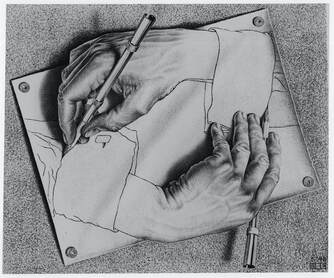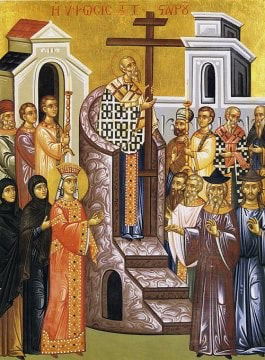 As one looks at the drawing above; we see a hand drawing another hand, but which is drawing the first hand, but which hand is drawing which? Our mind is challenged, it doesn’t make sense! This is so often true also of the faith we profess. We are often called to flip things upside down, to view things from a different perspective, to accept that, which to many, makes no sense or is illogical. It is all so paradoxical. Interestingly, Orthodox and Paradox are two words having much in common. The "dox" that ends both terms have roots in the Greek word doxa, which means "belief" or "opinion."(In later Christian usage, doxa came to mean "glory," but only as an extension of its much older philosophical meaning, which is "belief"). “Ortho” has a Greek root meaning to straight, correct, or upright.And so, if a doxa is an opinion or a belief, then ortho-doxa is a "correct or right belief."Similarly, the prefix “para” has a Greek root meaning "beyond" or "outside of"; and so, something that is "para doxa,", is beyond belief, contradicting what we might commonly believe to be true. For many, that which is ‘Orthodox’ often appears to be a ‘Paradox’. For instance, we are monotheists, we believe in one God. But we call that God a Trinity, one God in three persons; but how can God be both 1 and 3? – A paradox? Again, The Orthodox Church believes that Our Lord, Jesus, while on earth, was fully Immortal God and, at the same time, fully Mortal Man. How can He be both? And then of course we have the Mother of our Lord; A virgin mother? "O Mother that hath known no man, thou didst conceive, not experiencing corruption, lending a body to the Word, the Creator of all, becoming a receptacle to thine insupportable Creator, a dwelling-place to thine incomprehensible Maker." ________________________________________ On Monday it is the feast of The Elevation of the Holy Cross, also referred to as the Exaltation of the Cross, one of the Great Feasts of the Orthodox Church. This feast commemorates two events: Firstly, The finding of the Cross by the Empress Helen (the mother of St. Constantine the Great) on Golgotha in 326 AD, the place where Christ was crucified. Then recovery of the Cross from the Persians who had taken the Cross as a prize after sacking Jerusalem in 614 AD. It was recovered by the forces of the Byzantine Empire in 627 AD. The Cross was taken into the temple of the Resurrection, where it was joyously held up for veneration by the faithful. Now, when it comes to a paradox, is there anything more paradoxical than the Cross of Our Lord? As the Apostle Paul writes 1 Corinthians I: 23, “But we preach Christ crucified, unto the Jews a stumbling block, and unto the Greeks foolishness;” The Apostle tells us that the Jews seek signs because that is what the prophets gave them, although even then they did not believe. Their expectation of the Messiah was of one who would triumph over Israel’s enemies and establish Jerusalem as the centre of the world. Death by crucifixion was shameful and unthinkable. Their Messiah was to be exalted, not humiliated. Greek speculative philosophy generally regarded the realm of the spirit and ideas as good and vastly superior to the inferior world of matter. With such a world view the whole idea of a God who became man and assumed the limitations of mortality by assuming a material body subject to suffering and death, was unthinkable. For Greeks salvation was through the mystical reception of knowledge, which would free them from the bondage of the physical world and enable them to share in the spiritual realm. The whole cycle of creation and redemption was unthinkable to them. At the heart of the Orthodox Christian mysteries there is usually a paradox: The Creator who becomes a creature; the virgin who gives birth but remains a virgin; of the way to life being through death; of the poor being rich; of the weak being strong. To the unbeliever it is simply contradiction and disingenuous, proving the foolishness of the Gospel, and the credulity of Christians. To the believer, however, the wisdom of God is not the same as the wisdom of this world. Origen states that it is the world’s wisdom that is foolish “even though the simplicity of God’s wisdom makes those who have it appear foolish in the eyes of the world. Believers have received this divine wisdom and thus in this world appear to be fools.” It is not surprising therefore that the Orthodox Church has a whole category of saints known as “Fools for Christ.” From an object of destruction and shame, the cross has become the emblem of pride and respect. We raise it high over our churches; we decorate our most sacred objects with it whether they are buildings, or fabrics; we suspend it around our necks; we sign ourselves with the cross when we begin our prayers; we use it to bless our food. The Cross is a ubiquitous and potent symbol. In itself it is a means of grace. Saint Antony the Great speaks of defending himself by faith and the sign of the cross. Drawing Hands, Drawing by Maurits Cornelis Escher (1898-1972), Drawn in 1948, Pencil on paper  Troparion of the Exaltation of the Cross O Lord, save Thy people, and bless Thine inheritance. Grant victories to the Orthodox Christians over their adversaries; and by virtue of Thy Cross, preserve Thy habitation.
1 Comment
|
Parish Blog
This mainly contains homilies and messages from our priests, although there is some scope to share thoughts and interesting articles which we may want to share with others Archives
October 2022
Categories |
 RSS Feed
RSS Feed